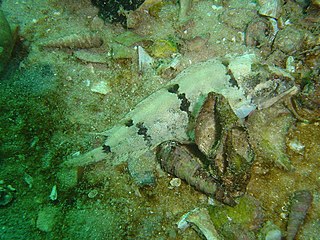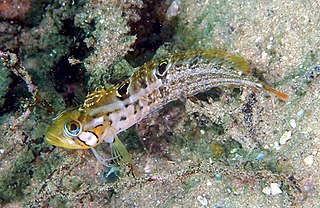
The Moronidae are a family of perciform fishes, commonly called the temperate basses, consisting of at least six freshwater, brackish water, and marine species. Many members of this family are anadromous.
This glossary of ichthyology is a list of definitions of terms and concepts used in ichthyology, the study of fishes.

Clinus is a genus of clinids found in the southeastern Atlantic and western Indian ocean.

Epinephelus andersoni, the catface grouper, brown-spotted grouper, catface rockcod or brown spotted rockcod, is a species of marine ray-finned fish, a grouper from the subfamily Epinephelinae which is part of the family Serranidae, which also includes the anthias and sea basses. It is found in the southwestern Indian Ocean where it is associated with reefs.

Cirrhibarbis capensis, the barbelled klipfish, is a species of clinid found in subtropical waters of the Atlantic Ocean around South Africa. This species can reach a maximum length of 36 centimetres (14 in) TL. This species preys primarily on benthic crustaceans, mostly amphipods and isopods. It is currently the only known member of its genus.
Climacoporus navalis, the fleet klipfish, is a species of clinid found in subtropical waters of the Atlantic Ocean along the coast of South Africa where it can be found in tide pools. This species can reach a maximum length of 7 centimetres (2.8 in) TL. It is currently the only known member of its genus.
Clinoporus biporosus, the ladder klipfish, is a species of clinid found in subtropical waters of the Atlantic Ocean around the South African coast. It occurs in the subtidal zone down to a depth of 30 metres (98 ft). This species can reach a maximum length of 13 centimetres (5.1 in) TL. It is currently the only known member of the genus Clinoporus.
Blennioclinus brachycephalus, the Lace klipfish, is a species of clinid found in subtropical waters of the Atlantic Ocean around South Africa. This species can reach a maximum length of 15 centimetres (5.9 in) TL. This species primarily preys on benthic fauna including isopods, amphipods, and mollusks.
Blennioclinus stella, the Silverbubble klipfish, is a species of clinid found in subtropical waters of the southeastern Atlantic and western Indian Ocean along the South African coast down to a depth of about 10 metres (33 ft). This species can reach a maximum length of 5 centimetres (2.0 in) TL.
Blennophis anguillaris, the snaky klipfish, is a species of clinid found in the subtropical waters of the Atlantic Ocean around South Africa. It can be found in the subtidal zone and also is a denizen of tidepools. This species can reach a maximum length of 30 centimetres (12 in) TL.

Blennophis striatus, the Striped klipfish, is a species of clinid found in the subtropical waters of the Atlantic Ocean from Saldanha Bay to East London, South Africa where it can be found in the subtidal zone as well as inhabiting tidepools. This species can reach a maximum length of 17.5 centimetres (6.9 in) TL.
Cancelloxus burrelli, the Slender platanna-klipfish, is a species of clinid found in subtropical waters of the Atlantic Ocean along the South African coast from the Orange River to Algoa Bay in South Africa. It can be found from the intertidal zone down to about 20 metres (66 ft). This species can reach a maximum length of 12 centimetres (4.7 in) TL.
Cancelloxus elongatus, the whiteblotched klipfish, is a species of clinid found in subtropical waters of the Atlantic Ocean along the South African coast. It prefers sandy habitats with nearby rocks at depths of from 10 to 25 metres. It can reach a maximum length of 5 centimetres (2.0 in) TL. This species preys primarily on zoobenthos.

Cancelloxus longior is a species of clinid found in subtropical waters of the South African coast. It can be found in areas with a sand substrate from the intertidal zone to a depth of about 10 metres (33 ft). Males of this species can reach a maximum length of 9.1 centimetres (3.6 in) SL, while females can reach a maximum length of 12.1 centimetres (4.8 in) SL.

Clinus acuminatus, the sad klipfish, is a species of fish in the family Clinidae. It is endemic to Southern Africa, where it occurs along the coast of Namibia and South Africa. It can reach a maximum length of 13 centimetres (5.1 in) TL and is viviparous. The sad klipfish feeds on crustaceans.

Clinus agilis, the agile klipfish, is a species of clinid found in subtropical waters of the Atlantic Ocean from Namibia to South Africa where it is commonly found in estuaries and tide pools. This species can reach a maximum length of 10 centimetres (3.9 in).
Clinus brevicristatus, the Cape klipfish, is a species of clinid that occurs in subtropical waters of the Atlantic Ocean around South Africa where it prefers habitats with plentiful growth of seaweed. This species can reach a maximum length of 12 centimetres (4.7 in) TL.

Clinus superciliosus, the Super klipfish or Highfin klipfish, is a species of clinid that occurs in subtropical waters of the Atlantic Ocean from northern Namibia to the Kei River in South Africa where it can be found in the subtidal and intertidal zones. This species can reach a maximum length of 30 centimetres (12 in) TL. This species feeds on benthic crustaceans including amphipods, isopods and crabs; sea urchins; gastropods; polychaete worms and other fishes.

Clinus venustris, the speckled klipfish, is a species of clinid that occurs in subtropical waters of the Atlantic Ocean from Namibia to South Africa where it is found in the subtidal zone as well as being a denizen of tide pools. This species can reach a maximum length of 12 centimetres (4.7 in) TL. and feeds primarily on amphipods, isopods, mysids, and echinoderms.
The lesser gurnard, or Quekket's gurnard, is a species of marine ray-finned fish belonging to the family Triglidae, the gurnards and sea robins. This species is found in the southwestern Indian Ocean and marginally in the southeastern Atlantic Ocean. This species is of commercial importance as a food fish.











